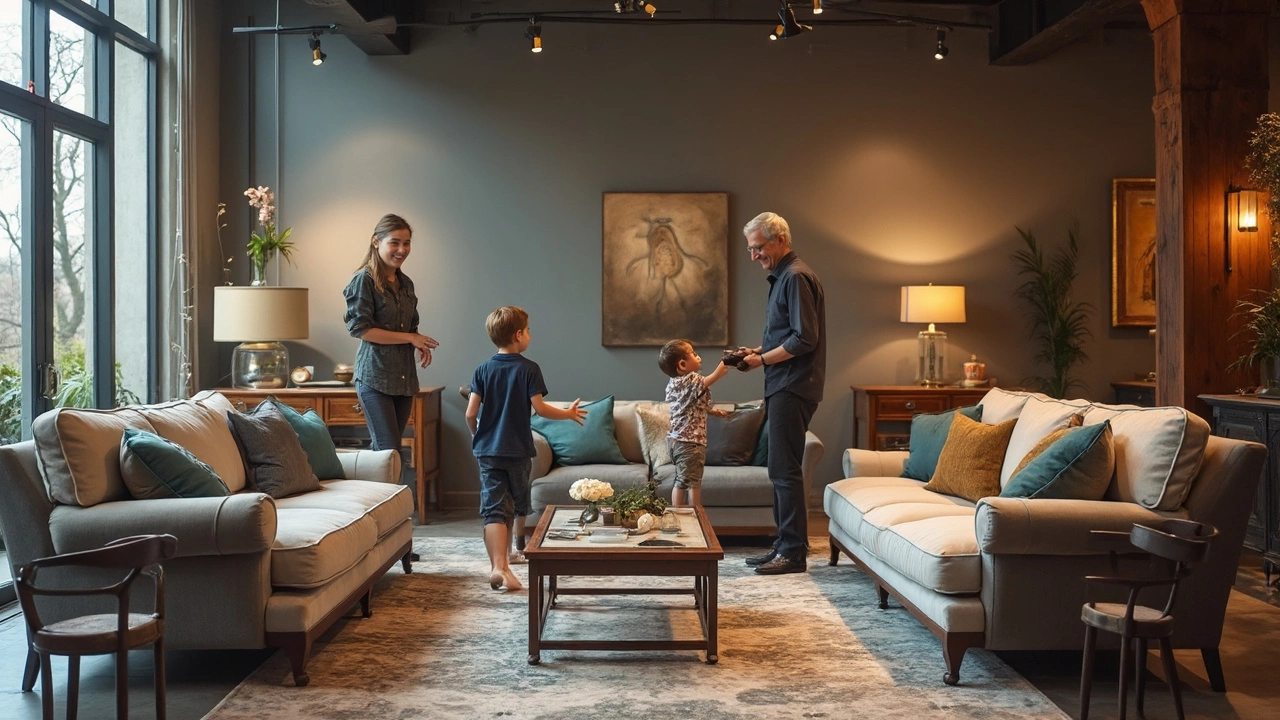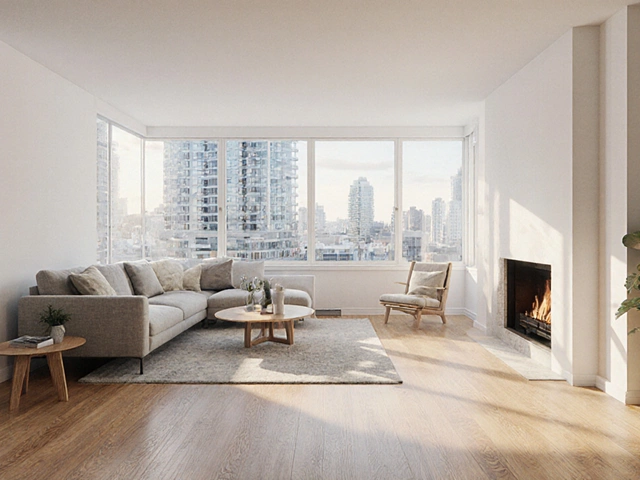Walk into any furniture store and you’ll probably hear people throwing around the words “sofa” and “couch” like they’re the same thing. Thing is, most folks don’t really know if there’s an actual difference—or if it’s just two names for something you flop onto after work. If you've ever wondered which term you should use, you’re not alone.
It actually gets a bit confusing because some people swear there’s a big difference, but ask two salespeople and you’ll get two different answers. At the end of the day, if you’re picking out something comfy for your living room, what matters isn’t the label but how it fits your style, your space, and, let’s be real, your afternoon nap needs.
Some stories say that the word “couch” used to mean a spot for napping, while “sofa” sounded fancier and meant for sitting upright—maybe to impress guests or your in-laws. But does that even hold up today? Let's break down where these words came from and what (if anything) really separates one from the other now.
- Where Did These Words Even Come From?
- The Design Details That Set Them Apart
- Does It Matter in Modern Shopping?
- Tips for Picking the Right One
- Fun Facts That Might Surprise You
Where Did These Words Even Come From?
Ever noticed how “sofa” sounds like something you’d read in a fancy home magazine, while “couch” feels a bit more casual? That’s not by accident. The words come from totally different backgrounds.
Let’s break it down:
- Sofa comes from the Arabic word “suffah,” which basically meant a bench covered in cushions. The word worked its way into Turkish as “sofa,” and then ended up in English because people loved the comfy furniture idea. “Sofa” started popping up in the 17th and 18th centuries in English households—pretty much the early days of living room furniture as we know it.
- Couch comes from the French “coucher,” meaning “to lie down.” Back in the day, a couch was more of a place for stretching out, which makes sense if you’re the type who likes to nap in the living room. Couches got popular in the Victorian era as an alternative to stiff-backed chairs.
Here’s a quick look at when these words first appeared, just to give you some context:
| Term | Origin Language | First Use in English |
|---|---|---|
| Sofa | Arabic (“suffah”) | 1625 |
| Couch | French (“coucher”) | 1300s |
So technically, the sofa actually showed up later—maybe that’s why it sounds a little more high-class to some people. Still, over the years, the differences have blurred, especially in the U.S. In the UK, “sofa” is almost always the go-to word, while North Americans switch back and forth, sometimes not even thinking about what makes each one special.
If you’re ever at a furniture store and someone insists there’s a big difference, now you know the history. The next time someone asks which word to use, it kind of depends on whether you want to sound like you’re sipping tea in an English townhouse or kicking back with pizza during game night.
The Design Details That Set Them Apart
If you lined up ten different seats in a room, could you pick out which one’s a sofa and which one’s a couch? It’s actually trickier than it sounds because modern furniture has mixed up a lot of the old style rules. But there are a few key details that have separated these two, at least when you look at their roots.
The word "couch" comes from the French word "coucher," which means "to lie down." Classic couches often had a slimmer design, maybe just a single arm or no arms at all, meant for a person to stretch out. Back in the day, these were the spots to recline, read, or grab a quick nap. You’ll still see couches that are lower to the ground or a bit more casual looking, sometimes with softer, overstuffed cushions that just beg you to sink in.
“Sofa,” on the other hand, has a fancier history—coming from an Arabic word that originally described a raised, cushioned bench. Sofas usually have arms on both sides and a full back. They’re designed for sitting together, with a bit more formal vibe. You’re likely to see more structured shapes, firmer cushions, and sometimes taller backs. This is what you’d put in your living room to host family or friends; it feels a little more put together than a typical couch.
- Couches: Lower arms (or one, or none), softer cushions, casual vibe.
- Sofas: Always have two arms, often with a tight back, a neater look.
Of course, it’s not a strict science—in 2025, furniture makers mix and match these features all the time. Marketing teams choose whichever word sounds better, so don’t get too hung up on labels when hunting for a sofa set.
| Feature | Couch | Sofa |
|---|---|---|
| Typical Design | Casual, often for lounging | Formal, for sitting |
| Number of Arms | Can be zero or one | Always two |
| Back Height | Usually lower | Usually higher |
| Cushion Style | Softer, overstuffed | Firmer, structured |
If you’re picking furniture for a busy family room, the laid-back design of a couch might suit you better. But if you want something that looks a bit sharper and can handle guests, the structure of a sofa might win out. What’s really important is how it feels to sit or lie down on—labels are just for fun.

Does It Matter in Modern Shopping?
So, when you’re actually out there shopping, does using "sofa" or "couch" make a difference? Most of the time, not really. Big brands and furniture stores use the words interchangeably. Walk into IKEA, West Elm, or even browse Amazon—they know people will search for both terms, so they tag everything with both. The main thing buyers want is something comfy, stylish, and sized right for their space.
If you’re searching online, though, using the sofa keyword tends to show a wider range of more structured, modern pieces, while "couch" sometimes pulls up more casual, plush options. But there’s a ton of crossover. Most salespeople don’t even blink if you use one word or the other. What they do notice are your specific needs: room layout, color, material, and budget.
Check out this quick table showing real shopping trends in 2024:
| Search Term | Monthly Searches (US) | Top Shopping Sites |
|---|---|---|
| Sofa | 368,000 | IKEA, Wayfair, West Elm |
| Couch | 301,000 | Amazon, Ashley, Target |
It’s interesting that "sofa" edges out "couch" in online searches, probably since it sounds a bit fancier. But on product tags or in customer reviews, you’ll see both words mashed together all the time, like "sofa couch" or "reclining sofa couch." No one gets corrected for it.
Stacy Cohen, a senior buyer at a major home retailer, puts it this way:
“Whether they say sofa or couch, our shoppers are looking for comfort and value. The word choice doesn’t affect the recommendations. We focus on lifestyle, fabric, and what will last in a busy home.”
The bottom line: in the current market, the difference barely matters. What matters is knowing the style and function you need. Don’t worry too much about being "correct"—the goal is to find a piece your household actually loves to sit on.
Tips for Picking the Right One
Stuck between a couch and a sofa? Here’s what really helps when making that call for your living room. Start with how you’ll actually use it. Movie marathons, working from home, or just hosting friends—each job calls for something a bit different.
- Measure Twice, Buy Once: Don’t just eyeball the space. Grab that tape measure before you fall for a beautiful piece that won’t fit your front door. Most living room layouts do well with furniture that leaves at least 18 inches between a seat and the coffee table.
- Style vs. Function: Sofas usually come with higher backs and firm arms—good for formal spaces or homes where you care about posture and keeping neat lines. Couches go lower and softer, great for lounging and a laid-back vibe.
- Family or Pets? Go with darker fabrics and removable covers. Microfiber is famously easy to clean, and leather (real or fake) doesn’t trap pet hair the way woven materials do.
- Seating Needs: Think about how many people use it daily. Three-seat models can fit a family, but if it’s just you and your dog, a smaller two-seater or loveseat works better and won’t crowd the room.
- Try Before You Buy: Sit, bounce, and even lie down in the store if you can. What looks comfy online might feel like a park bench in real life.
Here’s a cheat sheet for average dimensions. If you’re shopping online, these numbers can save you a headache:
| Type | Typical Length (inches) | Typical Depth (inches) | Typical Height (inches) |
|---|---|---|---|
| Sofa | 84 | 38 | 34 |
| Couch | 75 | 35 | 31 |
One more thing: Whether you call it a sofa or couch, go with what feels right for your home and how you live. Who cares about the name if it fits your needs and makes you happy every time you sit down?

Fun Facts That Might Surprise You
Turns out, a lot of weird and interesting things are hiding in the history of your living room seating. Here are some cool nuggets about the sofa world that most people never hear about:
- The word "sofa" comes from the Arabic word "suffah," which basically means a wooden bench covered in cushions and blankets. People have been plopping down on some version of a sofa since way back in the Middle Ages.
- "Couch" has roots in the French verb "coucher," meaning "to lie down." No wonder people think of couches as the place for naps.
- In the United States, "couch" is more common in informal settings, while "sofa" gets used in commercials and catalogs to sound more upscale. In the UK, the word "settee" is actually what you'd hear most often, which just adds to the confusion.
- The Guinness World Record for the longest sofa ever made is 1,006.61 meters—that’s over half a mile! This insane piece of furniture was built in Italy in 2011.
- More than half of Americans eat on their sofa or couch at least once a week. About 17% admit to never eating a meal at a real table. So, your sofa is handling a lot more than just Netflix binges.
Check out this table for some quick numbers on how people actually use their sofas and couches at home:
| Activity | Percentage of People |
|---|---|
| Watching TV | 82% |
| Napping | 48% |
| Eating Meals | 57% |
| Using a Laptop/Tablets | 39% |
If you want to keep your sofa or couch looking good, maybe get into the habit of eating at the table now and then—or at least keep a throw blanket handy for crumb emergencies.








